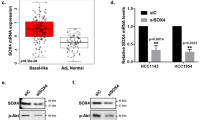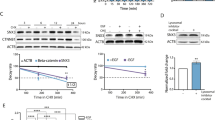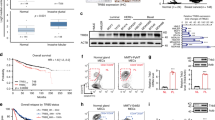Abstract
Accumulating evidence indicates that hyperactive Wnt signalling occurs in association with the development and progression of human breast cancer. As a consequence of engaging the canonical Wnt pathway, a β-catenin–T-cell factor (TCF) transcriptional complex is generated, which has been postulated to trigger the epithelial–mesenchymal transition (EMT) that characterizes the tissue-invasive phenotype. However, the molecular mechanisms by which the β-catenin–TCF complex induces EMT-like programmes remain undefined. Here, we demonstrate that canonical Wnt signalling engages tumour cell dedifferentiation and tissue-invasive activity through an Axin2-dependent pathway that stabilizes the Snail1 zinc-transcription factor, a key regulator of normal and neoplastic EMT programmes. Axin2 regulates EMT by acting as a nucleocytoplasmic chaperone for GSK3β, the dominant kinase responsible for controlling Snail1 protein turnover and activity. As dysregulated Wnt signalling marks a diverse array of cancerous tissue types, the identification of a β-catenin–TCF-regulated Axin2–GSK3β–Snail1 axis provides new mechanistic insights into cancer-associated EMT programmes.
This is a preview of subscription content, access via your institution
Access options
Subscribe to this journal
Receive 12 print issues and online access
$209.00 per year
only $17.42 per issue
Buy this article
- Purchase on Springer Link
- Instant access to full article PDF
Prices may be subject to local taxes which are calculated during checkout





Similar content being viewed by others
References
Cowin, P., Rowlands, T. M. & Hatsell, S. J. Cadherins and catenins in breast cancer. Curr. Opin. Cell Biol. 17, 499–508 (2005).
Chu, E. Y. et al. Canonical WNT signaling promotes mammary placode development and is essential for initiation of mammary gland morphogenesis. Development 131, 4819–4829 (2004).
Reya, T. & Clevers, H. Wnt signaling in stem cells and cancer. Nature 434, 843–850 (2005).
Li, Y. et al. Evidence that transgenes encoding components of the Wnt signaling pathway preferentially induce mammary cancers from progenitor cells. Proc. Natl Acad. Sci. USA 100, 15853–15858 (2003).
Liu, B. Y., McDermott, S. P., Khwaja, S. S. & Alexander, C. M. The transforming activity of Wnt effectors correlates with their ability to induce the accumulation of mammary progenitor cells. Proc. Natl Acad. Sci. USA 101, 4158–4163 (2004).
Rowlands, T. M., Pechenkina, I. V., Hatsell, S. J., Pestell, R. G. & Cowin, P. Dissecting the roles of β-catenin and cyclin D1 during mammary development and neoplasia. Proc. Natl Acad. Sci. USA 100, 11400–11405 (2003).
Bafico, A., Liu, G., Goldin, L., Harris, V. & Aaronson, S. A. An autocrine mechanism for constitutive Wnt pathway activation in human cancer cells. Cancer Cell 6, 497–506 (2004).
Teuliere, J. et al. Targeted activation of β-catenin signaling in basal mammary epithelial cells affects mammary development and leads to hyperplasia. Development 132, 267–277 (2005).
Ayyanan, A. et al. Increased Wnt signaling triggers oncogenic conversion of human breast epithelial cells by a Notch-dependent mechanism. Proc. Natl Acad. Sci. USA 103, 3799–3804 (2006).
Kemler, R. et al. Stabilization of β-catenin in the mouse zygote leads to premature epithelial-mesenchymal transition in the epiblast. Development 131, 5817–5824 (2004).
Jamora, C. et al. A signaling pathway involving TGF-β2 and Snail in hair follicle morphogenesis. PLoS Biol. 3, e11 (2005).
Salahshor, S. & Woodgett, J. R. The links between axin and carcinogenesis. J. Clin. Pathol. 58, 225–236 (2005).
Carver, E. A., Jiang, R., Lan, Y., Oram, K. F. & Gridley, T. The mouse snail gene encodes a key regulator of the epithelial–mesenchymal transition. Mol. Cell Biol. 21, 8184–8188 (2001).
Zhou, B. P. et al. Dual regulation of Snail by GSK-3β-mediated phosphorylation in control of epithelial–mesenchymal transition. Nature Cell Biol. 6, 931–940 (2004).
Barrallo-Gimeno, A. & Nieto, M. A. The Snail genes as inducers of cell movement and survival: Implications in development and cancer. Development 132, 3151–3161 (2005).
Moody, S. E. et al. The transcriptional repressor Snail promotes mammary tumor recurrence. Cancer Cell 8, 197–209 (2005).
Fujita, N. et al. MTA3, a Mi-2/NuRD complex subunit, regulates an invasive growth pathway in breast cancer. Cell 113, 207–219 (2003).
Yook, J. I., Li, X. Y., Ota, I., Fearon, E. R. & Weiss, S. J. Wnt-dependent regulation of the E-cadherin repressor Snail. J. Biol. Chem. 280, 11740–11748 (2005).
Sabeh, F. et al. Tumor cell traffic through the extracellular matrix is controlled by the membrane-anchored collagenase, MT1–MMP. J. Cell Biol. 167, 769–781 (2004).
Brabletz, T. et al. Variable β-catenin expression in colorectal cancers indicates tumor progression driven by the tumor environment. Proc. Natl Acad. Sci. USA 98, 10356–10361 (2001).
Kolligs, F. T., Hu, G., Dang, C. V. & Fearon, E. R. Neoplastic transformation of RK3E by mutant β-catenin requires deregulation of Tcf/Lef transcription but not activation of c-myc expression. Mol. Cell. Biol. 19, 5696–5706 (1999).
Stoothoff, W. H., Bailey, C. D. C., Mi, K., Lin, S. C. & Johnson, G. V. W. Axin negatively affects tau phosphorylation by glycogen synthase kinase 3β. J. Neurochem. 83, 904–913 (2002).
Cong, F. & Varmus, H. Nuclear–cytoplasmic shuttling of Axin regulates subcellular localization of β-catenin. Proc. Natl Acad. Sci. USA 101, 2882–2887 (2004).
Wiechens, N., Heinle, K., Englmeier, L., Schohl, A. & Fagotto, F. Nucleo-cytoplasmic shuttling of Axin, a negative regulator of the Wnt–β-catenin pathway. J. Biol. Chem. 279, 5263–5267 (2004).
Chia, I. V. & Costantini, F. Mouse Axin and Axin2/conductin proteins are functionally equivalent in vivo. Mol. Cell Biol. 25, 4371–4376 (2005).
Salas, T. R. et al. Glycogen synthase kinase-3β is involved in the phosphorylation and suppression of androgen receptor activity. J. Biol. Chem. 279, 19191–19200 (2004).
Dajani, R. et al. Structural basis for recruitment of glycogen synthase kinase 3β to the axin-APC scaffold complex. EMBO J. 22, 494–501 (2003).
Jope, R. S. & Johnson, G. V. W. The glamour and gloom of glycogen synthase kinase-3. Trends Biochem. Sci. 29, 95–102 (2004).
Yu, H. M. I. et al. The role of Axin2 in calvarial morphogenesis and craniosynostosis. Development 132, 1995–2005 (2005).
Franci, C. et al. Expression of Snail protein in tumor–stroma interface. Oncogene 25, 5134–5144 (2006).
Acknowledgements
We thank S. I. Jee for technical assistance with mRNA in situ hybridization and immunohistochemical staining. This study was supported by grants from the Korea Health 21 R&D Project, Ministry of Health & Welfare, Republic of Korea (A050550), the Basic Research Program of the Korea Science & Engineering Foundation (R01-2006-10203), the Korea Research Foundation (KRF-2005-005-J05903; J.I.Y.), and National Institutes of Health (NIH) grant 5 R01 CA71699 (S.J.W.).
Author information
Authors and Affiliations
Contributions
J.I.Y and X.-Y.L. were responsible for overall experimental work and design, I.O. and C.H. for CAM experiments, H.S.K., Y.J.C. and J.K for histochemistry of tissue samples, N.H.K., S.Y.C. and J.K.R. for DNA cloning, and E.R.F and S.J.W. for project planning and data analysis.
Corresponding author
Ethics declarations
Competing interests
The authors declare no competing financial interests.
Supplementary information
Supplementary Information
Supplementary Figures S1, S2, S3 and S4 (PDF 836 kb)
Rights and permissions
About this article
Cite this article
Yook, J., Li, XY., Ota, I. et al. A Wnt–Axin2–GSK3β cascade regulates Snail1 activity in breast cancer cells. Nat Cell Biol 8, 1398–1406 (2006). https://doi.org/10.1038/ncb1508
Received:
Accepted:
Published:
Issue Date:
DOI: https://doi.org/10.1038/ncb1508
This article is cited by
-
P4HA3 promotes clear cell renal cell carcinoma progression via the PI3K/AKT/GSK3β pathway
Medical Oncology (2023)
-
A nomogram combining clinical factors and biomarkers for predicting the recurrence of high-risk cutaneous squamous cell carcinoma
BMC Cancer (2022)
-
Long non-coding RNAs as the critical regulators of epithelial mesenchymal transition in colorectal tumor cells: an overview
Cancer Cell International (2022)
-
PRMT5 activates AKT via methylation to promote tumor metastasis
Nature Communications (2022)
-
Overexpression of TGF-β1 and SDF-1 in cervical cancer-associated fibroblasts promotes cell growth, invasion and migration
Archives of Gynecology and Obstetrics (2022)



